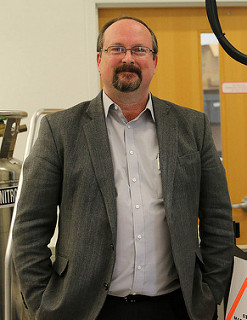Published on
Metabolomics center delves into the unknown
Emily Kummerfeld | Bond LSC
What do you do when you have an unknown substance and need to know what it’s made of? Or what if you know what’s in it, just not how much?
Scientists turn to metabolomics to figure out what these pieces are.
Lloyd W. Sumner, Director of the Metabolomics Center at MU’s Bond Life Sciences Center, said analyzing a sample is like going to the doctor and having blood drawn to assess what’s happening inside of your body.
“Plants can’t tell us what’s going on, animals can’t do that either, so we need high resolution biochemical phenotyping to understand how organisms respond to stress and disease. Instead of profiling one, five, 10 or 30 compounds, we’re profiling hundreds to thousands of metabolites, and we use that to assess the biochemical phenotype and how the system is responding,” Dr. Sumner explained.

This is achieved using methods called chromatography and mass spectrometry. These methods separate and analyze hundreds to thousands of metabolites to better understand the biochemistry of living organisms. Metabolites are the molecules a cell creates that provide the building blocks and energy sources enabling a plant or animal to grow, reproduce and respond to its environment. These small molecules can tell us a lot about an organism.
So how exactly how does mass spectrometry work? It really is the science of weighing molecules. It can identify small molecules, quantify known compounds and reveal structural and chemical properties. Crime shows on TV employ the technique in forensic investigations to analyze the molecular composition of unknown substances found at a crime scene.
Let’s break down the process for you.
The first step is actually chromatography, where the molecules in a mixture are separated based on chemical properties. This helps to see individual metabolites within complex mixtures from plants, animals and microbes. Two of the most common types are gas and liquid chromatography. Sumner’s lab uses both since some molecules cannot be heated during gas chromatography and need to be separated via liquid chromatography.
In gas chromatography, a sample is heated until it vaporizes and then travels through a thin glass tube and interacts with a coating on the tube wall. These interactions vary and help separate all the sample’s parts. The speed at which each separate molecule travels helps us determine the identity of each part.
Here’s where the mass spectrometer takes over. As each small molecule/metabolite exits the chromatography column, it enters through the inlet system, and passes through an ionization system that puts a charge on the molecules, since a mass spectrometer does not weigh actual mass but rather the mass-to-charge ratio of the molecular ions. Once the ions are formed, they go through the mass analyzer, which will tell the ions apart based on their mass to charge ratio. From there, the ions hit a detector where a resultant current is measured. This gives scientists a graph of sorts, showing a series of peaks for each substance, with higher peaks indicating more of the molecule in a sample.
This data from both chromatography and the mass spectrometer is then used to figure out exactly what was in the unknown sample.
Control is the name of the game when it comes to getting accurate results. The system keeps samples in a vacuum so molecules can move around without colliding with other gas molecules, because bad things can happen when they do.
“They can deflect the trajectory of the ions as they’re moving through the instrument, there can be charge loss and neutralization of that, but ultimately all of those affect sensitivity,” Sumner said.
Depending on what Sumner’s team is trying to figure out, other types of mass analyzers can come into play. From quadrapole mass analyzers to magnetic sector instruments, to time-of-flight analyzers, they separate the ions in different ways.
Not all mass analyzers are equal as Dr. Sumner explained, “these different types of mass spectrometers have different performance metrics. And as resolution and sensitivity go up, usually cost does, too. But for the most part, we use mostly TOF (time-of-flight) analyzers because they have good mass resolution and the cost is kind of modest.”
The way a time-of-flight analyzer separates ions is actually quite simple. A burst of ions is emitted and accelerated, and the ions are measured based on their flight time over a specific distance, meaning the smaller and lighter the ion, the faster it will be, with each molecule having a unique time-of-flight.
So how does Dr. Sumner use mass spectrometry in his own research? Currently, his work focuses on plant biochemistry.
“We’re trying to understand how plants synthesize triterpenoids. These are important plant compounds that plants use them to defend themselves. They can’t get up and run away, so they make these defense-related compounds,” Sumner said.
The Metabolomics Center benefits more researchers than just Sumner’s team.
For example, his center is collaborating with other faculty on an animal stress test for milk. That’s because the technology at the center can be applied widely to science not only here on campus but nationally and internationally.
An added bonus for Sumner is that his center feeds his fascination with sophisticated analytical instrumentation and electronics, or “shiny toys,” since once “you understand how they work, you get a greater appreciation for them,” he says.
Lloyd Sumner is a professor of biochemistry and director of the University of Missouri Metabolomics Center at the Bond Life Sciences Center. The Metabolomics Center, which opened in August of 2016, is one of ten research core facilities at the University of Missouri. Learn more about the center at http://metabolomics.missouri.edu.